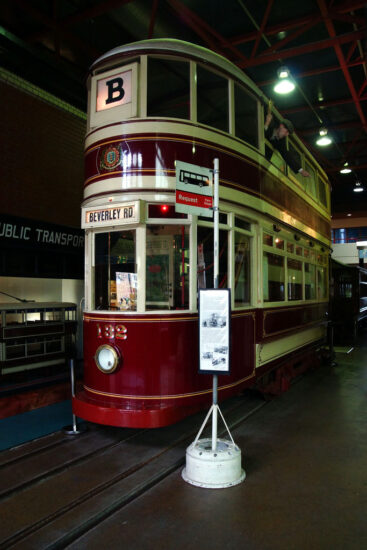In this pictorial article we take a trip to the Streetlife Museum in Hull which has been open since 1989 and is currently home to three exhibits with tram connections – one which is very local and the others which are a long-way from home! They are Hull 132 (on long-term loan from the Tramway Museum Society), Ryde Pier Tramway 3 and Portstewart Tramway Tram Engine 1. These photos were taken by David Mee on 14th August 2021.
Entry to the Streetlife Museum is free and once inside you will find recreated street scenes where the exhibits are displayed along with display cases which includes some model trams. Although the museum opened in 1989 it can trace its history back to the early 20th century when the collection started to be established. Operated by Hull Museums (a department of Hull City Council) it is located in the Museums Quarter in the city which also includes the Hull and East Riding Museum, the Arctic Corsair trawler and Wilberforce House Museum.
- More details about the museum can be found on the Hull City Council website at https://www.hcandl.co.uk/museums-and-galleries/streetlife-museum/streetlife-museum

Hull 132 is on loan at the Streetlife Museum from the Tramway Museum Society having been cosmetically restored. After discussions in recent years the loan agreement has now been extended and the tram will remain on display in its home city for some time to come. The museum isn’t the easiest to photograph with cramped conditions and low-level lighting but here we see 132.

A second look at 132. Built in 1910 the tram was acquired by Leeds in 1942 (renumbered 446) before it was withdrawn for the last time in 1952. After preservation it moved to Crich in 1960 and moved to Hull during the 1980s. Note the angry man in the upper deck window!

The second tram based exhibit is this 1871 vehicle which once ran along the Ryde Pier Tramway on the Isle of Wight. Numbered 3 it has also been cosmetically restored. A later example from the Pier Tramway has recently been restored for the Isle of Wight Steam Railway.

A view of 3 again with Hull 132 behind. The Ryde Pier Tramway started off operated by horse before trying steam power, electricity, petrol and diesel! 3 stayed in service until 1935 when it was damaged after being pushed through the buffers on the Pier. It is now the oldest surviving tram in the country.

The third and final large scale tram object is Portstewart Tramway Tram Engine 1, a 1882 built Kitson built steam tram. It too has been cosmetically restored for display. According to the information displays there is a tenuous link between Hull’s original steam tramway along with both the Portstewart line and the Ryde Pier Tramway – they were the three shortest tramways in Britain. Although we doubt that’s why these vehicles have all ended up in Hull! (All Photographs by David Mee, 14th August 2021)
